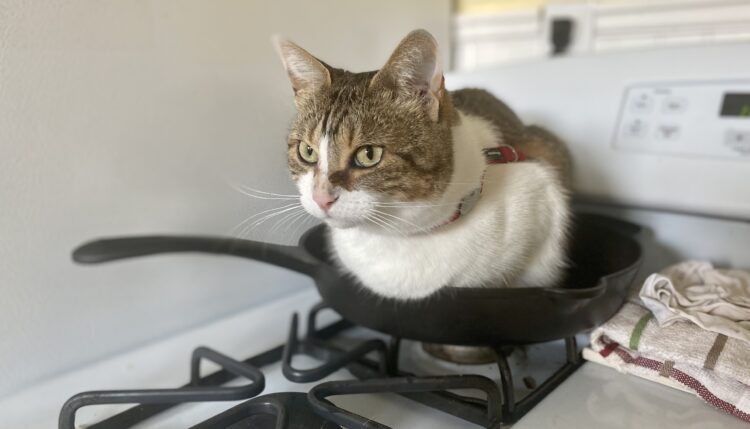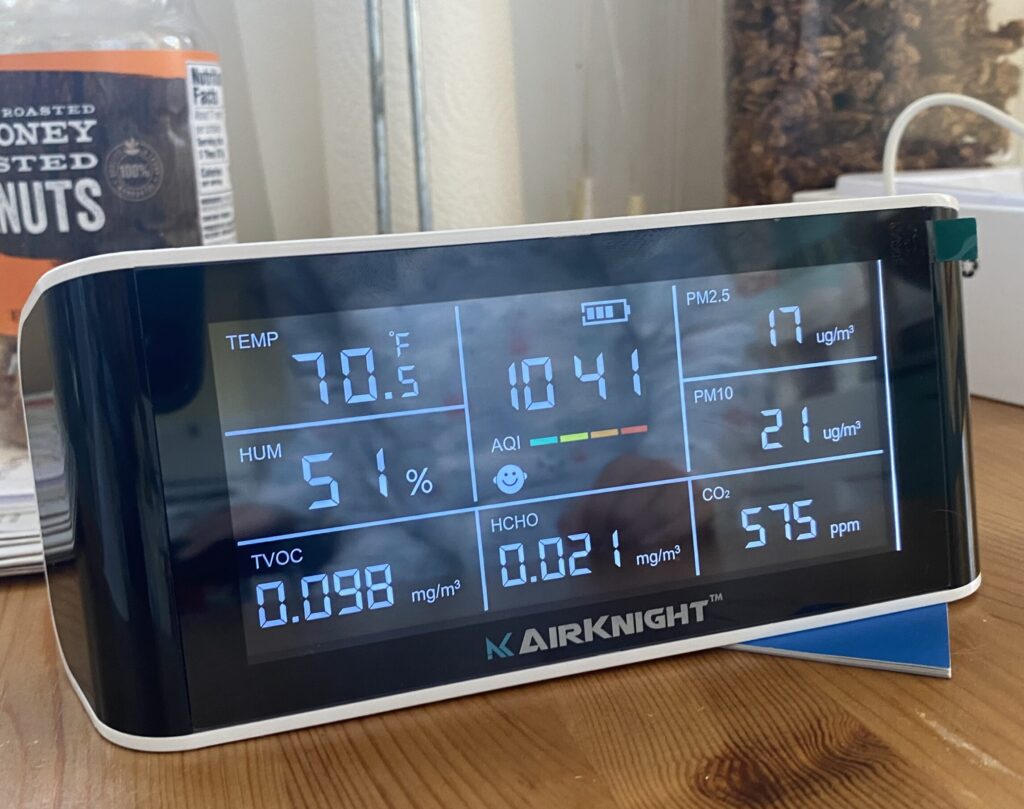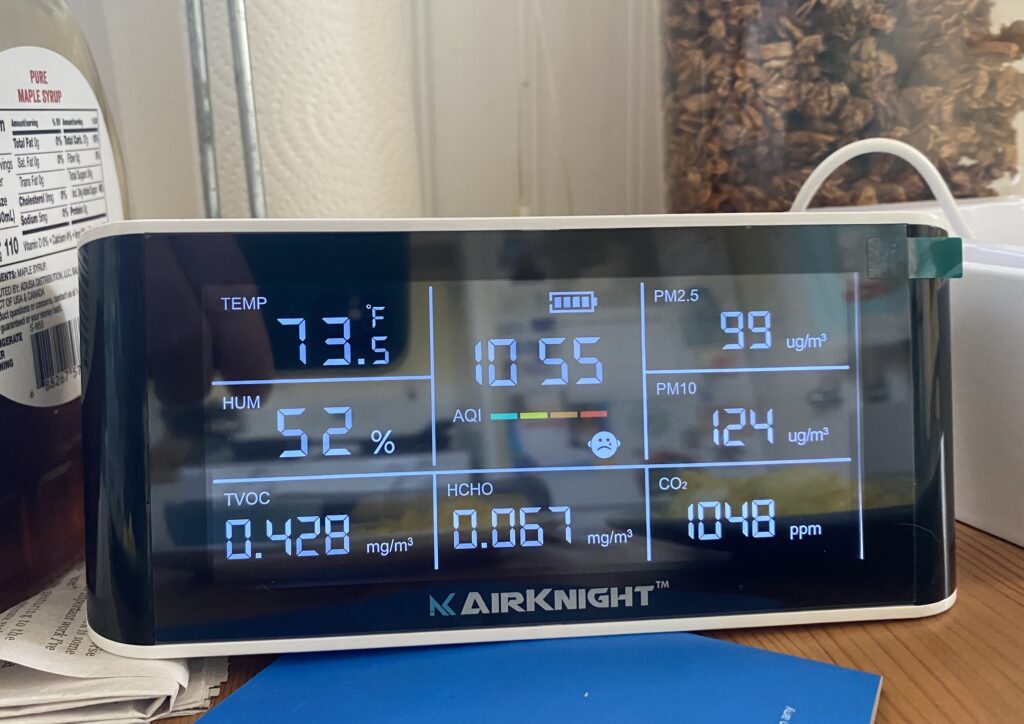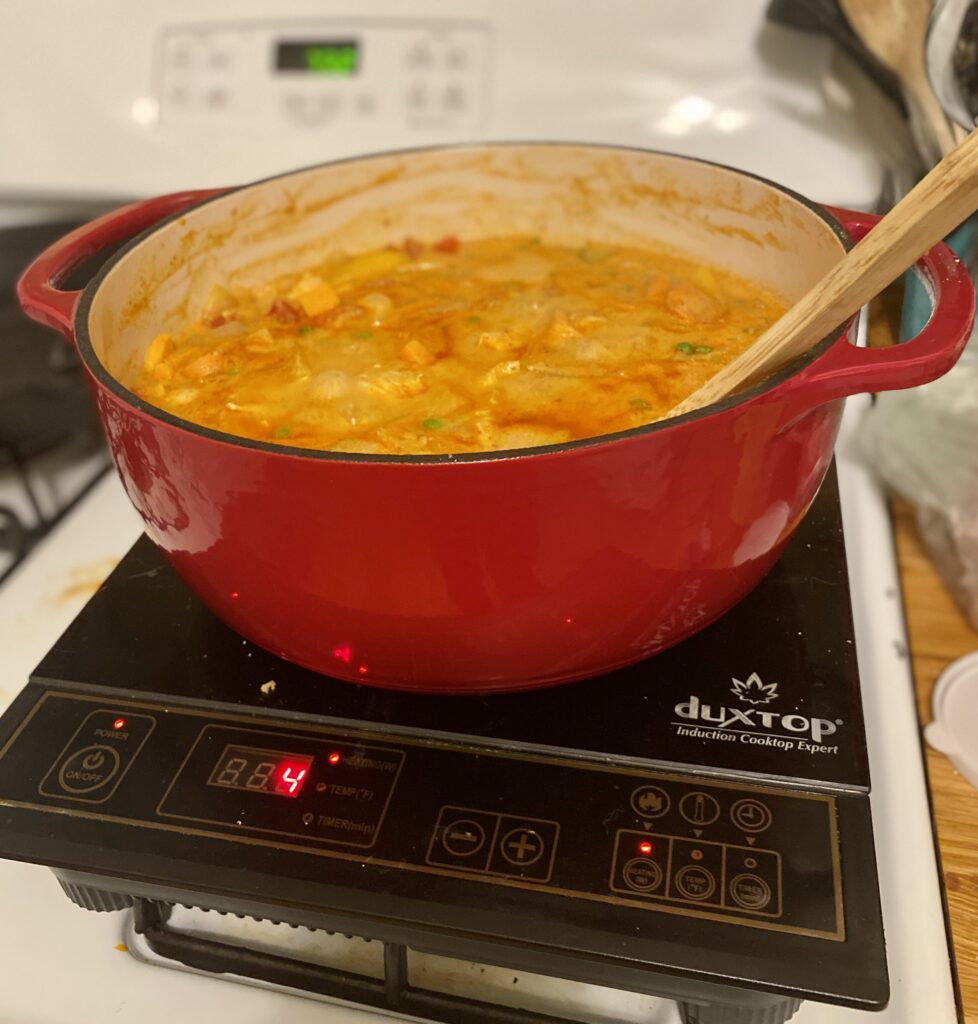I recently wrote an article about sourcing healthier home materials — and I learned a whole bunch of scary stuff in the process. Your home is supposed to be a sanctuary, but a…

I used to love them, but gas stoves are really bad news
(Note: No cats were cooked or otherwise harmed in the creation of this blog post; Athena just likes to sit in a frying pan sometimes, like a total weirdo.)
When we bought our house, one of my must-haves was a gas stove. My parents had an electric range growing up, and the first time I got to use a gas cooktop, in a rental apartment, I was simply floored. I felt like a real chef! It was so responsive! I vowed never to go back.
And I didn’t. I love our gas stove. I’ve cooked dinner on it almost every night of my 11-year-old daughter’s life. There’s something innately appealing about cooking over an open fire, and I appreciate that we can still cook pasta during a power outage. What I didn’t know — few of us did — was that I was putting her, and the rest of our family, in considerable danger.
The dangers of gas stoves
A mountain of research has confirmed that gas stoves make for risky roommates. Children in households with gas stoves are far more likely to suffer from asthma; gas ranges are responsible for an estimated 13% of all childhood asthma cases in the US. Gas stoves release a lot of carbon monoxide indoors and, worse, the toxic carcinogen benzene, which is known to cause leukemia, among other health problems. They’re estimated to cause 36,000 premature deaths a year in Europe.
And OK, it turns out some people did know about this. The gas companies! A new NPR investigation found that gas companies learned more than 50 years ago (!) that burning methane indoors with barely any ventilation throws off a ton of nitrogen dioxide and can cause asthma and other respiratory illnesses.
I mean, as I type that out, I realize maybe we all should have realized sooner that of course lighting stuff on fire inside an enclosed kitchen is probably not a great idea? But there’s a reason we didn’t know that: Gas companies used the same tactics tobacco companies used to muddy, discredit, and shroud the science proving their product was harmful. And at the same time, they marketed gas as the premiere cooking technology — and we fell for it.
As electric stoves grew more common than gas ones in the 1950s and 60s, the gas industry spent millions of dollars convincing people that cooking over a gas flame was superior to an electric stove. (“Now you’re cooking with gas” isn’t an old saying — it’s an old advertising slogan.) And I, like so many other Americans, absolutely bought into it.
The genius of that campaign is this: Even though stoves themselves don’t use a lot of gas, the industry views them as a “gateway appliance.” A homebuyer like myself insists on having a gas range for cooking, and that means they want a gas line to the house… which in turn makes them far more likely to use gas for more intensive purposes — for their furnace, hot water heater, and clothes dryer.
Now, here’s the thing. Study says this, research says that, it’s perhaps easy to dismiss these things when they sound more or less theoretical. But we got an air quality monitor (affiliate link) last winter, and I set it up in the kitchen a few days in a row, while I was cooking dinner or breakfast. The results were… pretty shocking, really.
In less than 15 minutes, for example, after cooking French toast and eggs on the stovetop one Sunday morning, the air quality monitor quickly went from a green “everything’s ok” smiley face to a red frowny face.

The concentration of fine particulates in our kitchen, which can lodge deep inside the lungs, increased fivefold after using the stove for just 15 minutes.
The amount of formaldehyde (HCHO) in the air tripled.
And the total volatile organic compounds (TVOC) — chemicals like benzene and other bad stuff — more than quadrupled.

That is not great! Part of the issue is, no doubt, the byproduct of cooking in any fashion — there’s a bit of smoke, extra heat, etc. — so it’s always good to use a range hood if you have one, or open a window to ventilate your cooking space. But the gas stove clearly wasn’t helping matters.
Gas vs. induction stoves: A better way to cook
I’m not going to lie: I cook a ton, and I still think a gas range provides a better cooking experience than a traditional electric stove. BUT. BUT! Note the word “traditional.”
There’s nothing traditional about electric induction stoves. They’re technological marvels, and they’re amazing.
Induction cooktops use electricity, but not in the way you’re used to. Instead of heating up a coil ’til it’s bright red and scary hot, they heat a pot or pan using a magnetic field. MAGNETS?! Yup.
I wanted to try out the technology, so I bought us a portable induction cooktop (affiliate link) — sort of like a single-burner induction hotplate. And the honest truth? The induction cooktop is fantastic.
It heats up SO fast! It cools down instantly if you dial it down from 9 to 3 or whatever — the same or better responsiveness you get from a gas flame — and allows for a perfectly precise simmer. And, best of all, it’s not spewing BENZENE into our home like a filthy chainsmoker. It’s also super easy to clean, as it’s just one flat surface.

So for now, the induction cooktop sits on top of the right-hand burners, having won my informal gas vs. induction stove challenge. (It’s also just handy to have an extra burner if we’re ever making a huge meal.)
I use the induction cooktop for pretty much all of my stovetop cooking now; I still have to use the gas oven for baking, and sometimes for a second burner if it’s a two-pot meal (in which cases I make sure to open the window). But the induction technology works wonderfully, and the next stove we buy will definitely be an induction appliance.
We’ll have to upgrade the outlet near the stove first, as most full-size induction stoves require a 240V outlet. But gratefully there are some rebates available to ease the transition, including a $500 rebate through MassSave, and up to $840 off an induction stove through the Inflation Reduction Act.
For now, though, a simple $50 cooktop has greatly reduced the likelihood that I’m giving my kid asthma or something worse when I’m boiling her mac n’ cheese. And that’s worth a lot more than 50 bucks.




